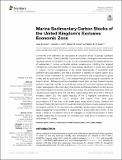Files in this item
Marine sedimentary carbon stocks of the United Kingdom’s Exclusive Economic Zone
Item metadata
| dc.contributor.author | Smeaton, Craig | |
| dc.contributor.author | Hunt, Corallie Anne | |
| dc.contributor.author | Turrell, Bill | |
| dc.contributor.author | Austin, William | |
| dc.date.accessioned | 2021-03-04T11:30:10Z | |
| dc.date.available | 2021-03-04T11:30:10Z | |
| dc.date.issued | 2021-03-04 | |
| dc.identifier | 272417372 | |
| dc.identifier | 3b97dc4e-9983-415d-83c1-7ba119441589 | |
| dc.identifier | 85102839265 | |
| dc.identifier | 000629754700001 | |
| dc.identifier.citation | Smeaton , C , Hunt , C A , Turrell , B & Austin , W 2021 , ' Marine sedimentary carbon stocks of the United Kingdom’s Exclusive Economic Zone ' , Frontiers in Earth Science , vol. 9 , 593324 . https://doi.org/10.3389/feart.2021.593324 | en |
| dc.identifier.issn | 2296-6463 | |
| dc.identifier.other | ORCID: /0000-0003-4535-2555/work/90112331 | |
| dc.identifier.other | ORCID: /0000-0002-1955-7277/work/90112634 | |
| dc.identifier.other | ORCID: /0000-0002-1889-1468/work/145031197 | |
| dc.identifier.uri | https://hdl.handle.net/10023/21555 | |
| dc.description | This work was supported by Marine Scotland through the Blue Carbon Forum. Additional support from the NERC Life Sciences Mass Spectrometry Facility (CEH_L_115_05_2018) allowed additional analytical work to be undertaken. BGS provided access to samples through their In-kind sample loan scheme (Loan: 273227). | en |
| dc.description.abstract | Continental shelf sediments are recognized as long-term stores of globally significant quantities of carbon (C) and potentially provide an important, yet largely overlooked climate regulation service via the Earth’s C cycle. Current understanding of the spatial distribution of sedimentary C across continental shelves remains poor, inhibiting the targeted management and potential inclusion of these globally significant C stores into national C budgets. Further understanding of the spatial heterogeneity of continental shelf sediments and associated C provides a foundation to quantify the organic carbon (OC) stock and better understand the role that marine sediments play in regulating the global climate and the potential for CO2 to be released through anthropogenic disturbance of these C stores. Utilizing a spectrum of available marine data, we have created bespoke sediment maps that quantify the surficial (top 10 cm) OC stock and highlight significant spatial heterogeneity in the distribution of sediments and their associated C content across the United Kingdom’s Exclusive Economic Zone (EEZ). The surficial sediments within the UK EEZ are estimated to store 524 ± 68 Mt of organic carbon (OC) and 2,582 ± 168 Mt of inorganic carbon (IC). The spatial mapping of this C highlights well-defined OC accumulation hotspots in fjords, estuaries and coastal muds, while large accumulations of IC are found in the tidally swept areas around Orkney, Shetland and the South West of England. Within the well-defined OC hotspots, muddy sediments store the greatest quantity of OC; the muds offer potentially valuable opportunities for targeted future management and protection of sedimentary C stores within the UK EEZ. In the future, if areas of the seafloor were to be managed to include the protection of these valuable sedimentary C resources, we recommend an initial focus on hotspots of high sedimentary OC density. | |
| dc.format.extent | 3966627 | |
| dc.language.iso | eng | |
| dc.relation.ispartof | Frontiers in Earth Science | en |
| dc.subject | Carbon | en |
| dc.subject | Sediment | en |
| dc.subject | Seabed | en |
| dc.subject | Organic carbon | en |
| dc.subject | Inorganic carbon | en |
| dc.subject | Stock | en |
| dc.subject | Spatial | en |
| dc.subject | Mapping | en |
| dc.subject | GC Oceanography | en |
| dc.subject | QE Geology | en |
| dc.subject | GB Physical geography | en |
| dc.subject | DAS | en |
| dc.subject | SDG 13 - Climate Action | en |
| dc.subject | SDG 14 - Life Below Water | en |
| dc.subject.lcc | GC | en |
| dc.subject.lcc | QE | en |
| dc.subject.lcc | GB | en |
| dc.title | Marine sedimentary carbon stocks of the United Kingdom’s Exclusive Economic Zone | en |
| dc.type | Journal article | en |
| dc.contributor.institution | University of St Andrews. School of Geography & Sustainable Development | en |
| dc.contributor.institution | University of St Andrews. Environmental Change Research Group | en |
| dc.contributor.institution | University of St Andrews. Bell-Edwards Geographic Data Institute | en |
| dc.contributor.institution | University of St Andrews. Scottish Oceans Institute | en |
| dc.contributor.institution | University of St Andrews. Coastal Resources Management Group | en |
| dc.contributor.institution | University of St Andrews. Marine Alliance for Science & Technology Scotland | en |
| dc.contributor.institution | University of St Andrews. St Andrews Sustainability Institute | en |
| dc.identifier.doi | https://doi.org/10.3389/feart.2021.593324 | |
| dc.description.status | Peer reviewed | en |
| dc.date.embargoedUntil | 2021-03-04 |
This item appears in the following Collection(s)
Items in the St Andrews Research Repository are protected by copyright, with all rights reserved, unless otherwise indicated.

